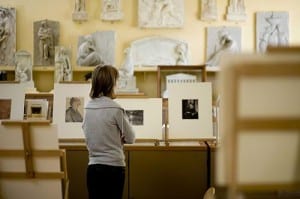And now, a word from our sponsors: teaching and art at UCL Art Collections
By Subhadra Das, on 18 May 2011
Like the rest of UCL Museums & Collections, the primary audience for UCL Art Collections is UCL students and staff. Objects from the collections are a source of inspiration to students at the Slade School of Art, and are regularly used for teaching by lecturers from departments from the usual suspects – History and History of Art – to English, Geography and Science and Technology Studies.
That’s why, this week, we asked some of the people who have recently worked with the collections to share their views.
First up is Nina Rodin, one of the contributing artists to Moreover, this year’s Slade/Strang collaboration. For the third year in a row, students from the Slade have looked at objects from the museum and reinterpreted these classic and modern artworks to make their own original artworks. You can read more about Nina’s work for Moreover on her blog.
Facilitating teaching with the collections is also a very important part of what we do in the museum. We asked Dr Nick Grindle, from UCL History of Art, to write about the experience of teaching with the collections. Here’s what he had to say:
“In March a group of seven final-year History of Art undergraduates curated a small one-day exhibition in the Strang print room on the subject of ‘genius.’ The students were asked to select three prints and write a brief commentary that explained the relationship between printmaking and poplar notions of artistic ‘genius’ in early nineteenth century Britain. The exhibition’s target audience was a second year group studying British art and architecture. The exhibition was an opportunity for the third year group to consolidate their studies and for the second years to grow their knowledge of the subject. The second years had also spent an earlier class looking at techniques of sculpture modelling, painting, and drawing in UCL collections, and so this look at printmaking built on that earlier experience too.
The curators were put in a challenging position, being given only one hour to choose the three prints and draft an accompanying text. They deliberated for some time about which prints to choose, but wrote the text quite easily, having chosen one of their number as editor. I gave them the task and sat back to see how they tackled it.
What surprised me was that having chosen the three prints and put them on stands on a cabinet in the centre of the print room, all seven curators then physically turned their backs on the prints, sat round the table, and began to hammer out the text. They recognised the social potential of the environment (being able to sit down in a nice room and work closely with one another) rather than its cognitive potential (being able to work closely with the objects as they were writing about them). I am sure this has a lot to do with the way we prime students to read and write, but not to look. This is a shame because the Strang has a table in the middle precisely to help the students marry their looking with their study.
On reflection, the third years acknowledged that learning with objects was challenging. Some said it suited their learning styles, while others did not. They agreed that the exercise helped them develop conceptual frameworks based on a study of the objects. The second years also recognised the value of first-hand engagement with objects: ‘I did note the different techniques used in those prints, which goes to show that the class where we had that tour around school was something memorable and of great usefulness to our course;’ ‘I do think that bringing images from the Strang Print Room into the lecture is a great way to make use of what UCL has at hand in terms of a valuable resource’; ‘it was a nice break from essay writing!’
The curators said they enjoyed it immensely. It consolitated their learning, and fitted nicely and easily into our scheduled class time. It enabled the second years to expand their knowledge of the period, and it also fitted easily into their schedules, taking only five minutes to see, and being located in the centre of college.”
 Close
Close


